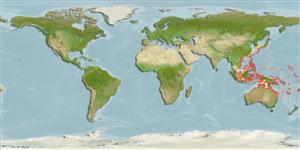>
Eupercaria/misc (Various families in series Eupercaria) >
Haemulidae (Grunts) > Plectorhinchinae
Etymology: Plectorhinchus: Greek, plektos = plaited + Greek, rhyngchos = snout (Ref. 45335).
Eponymy: René Primevère Lesson (1794–1849) was a French naturalist and surgeon. [...] (Ref. 128868), visit book page.
More on author: Cuvier.
Environment: milieu / climate zone / depth range / distribution range
Ecología
marino asociado a arrecife; rango de profundidad 1 - 35 m (Ref. 90102). Tropical
Western Pacific: Malaysia to Melanesia, north to Japan.
Tamaño / Peso / Age
Maturity: Lm ? range ? - ? cm
Max length : 40.0 cm TL macho / no sexado; (Ref. 27362)
Espinas dorsales (total) : 12 - 13; Radios blandos dorsales (total) : 18 - 22; Espinas anales: 3; Radios blandos anales: 7 - 8.
Inner and outer reef lagoons, usually in caves along steep slopes. Juveniles in shallow lagoons or protected shallow reefs (Ref. 48635). During the day, occurs under coral ledges of channel and outer reef slopes (Ref. 37816). Solitary (Ref. 90102).
Life cycle and mating behavior
Madurez | Reproducción | Puesta | Huevos | Fecundidad | Larva
Oviparous, distinct pairing during breeding (Ref. 205).
Randall, J.E., G.R. Allen and R.C. Steene, 1997. Fishes of the Great Barrier Reef and Coral Sea. Second Edition. Revised and expanded edition. Crawford House Publishing Pty Ltd. Bathurst, NSW, Australia. 557 p. (Ref. 27362)
IUCN Red List Status (Ref. 130435: Version 2024-1)
Threat to humans
Harmless
Human uses
Herramientas
Can't connect to MySQL database fbquizv2. Errorcode: Too many connections
